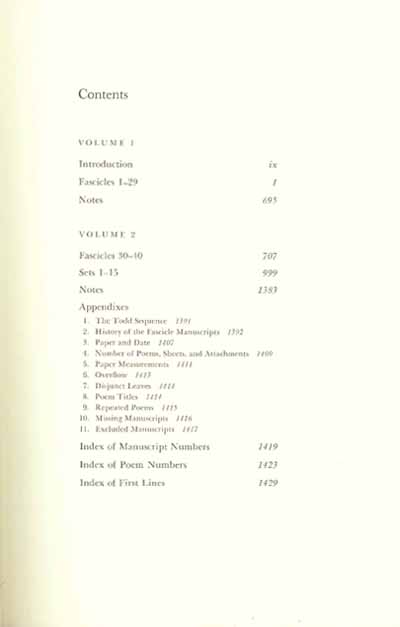Mary
Lee Hall, both descendants needed to know which poems remained
unpublished. To indicate which ones, Bianchi wrote No on
many manuscripts in her possession; she also conducted several counts
and recorded her tallies (see p. 285). For Bingham the letter u
indicated that a poem remained unpublished, To show publication she
used I, II, and III for the three
nineteenth-century volumes and abbreviations or short titles, such as SH,
EP, UP, and Letters, for the others (see
Fascicle 1). Both libraries numbered the manuscripts they received.
INTRODUCTIONS
TO THE FASCICLES AND SETS list the poems contained in them and
describe their date, paper, and makeup. The Todd numbers, as
applied in 1891, are recorded for each (compare Appendix 2).
The description indicates whether the paper is laid or wove, ruled or
unruled, and includes the nature of the design, if embossed.
Common color names have been used: white, cream, bluish white,
greenish white, grayish white, and beige. These may be
compared, respectively, to the ISCC-NBS Color-Name Charts (Supplement
to National Bureau of Standards Circular 553) for white (Centroid
263), yellowish white (92), bluish white (189), greenish white (153),
light gray (264), and yellowish gray (93). In most instances the
actual color is much lighter than the standard. Because of
minute but frequent variation in size from sheet to sheet of the same
paper type, overall dimensions, and those for the embossed design,
are summarized in Appendix 5.
Although
the fascicles and sets were not printed and folded like a book, the
conventions of standard bibliographical description can be used to
express the patterns of sheets, half-sheets, and attachments.
The descriptive formulas begin with a statement of format, almost
always folio (2o) since most of the sheets had been folded
by the manufacturer to produce two conjugate leaves. In two
sets Dickinson used a tablet style paper without a fold (1o).
Because she did not mark sheets, their numbers in the formulas
have been supplied editorially and thus recorded in italic type.
A superscript figure indicates the number of leaves in each sheet.
2o: 1-42,
8 leaves.
This
description of Fascicle 1, typical of many, states the format to be
folio (2o) and records four sheets (1-42),
unmarked, for a total of eight leaves.
xviii


